Contents
Market Overview
Macro Review
The trading week ended with data showing that U.S. nonfarm payrolls increased with another solid 263,000 in September after a 315,000 gain in August. The unemployment rate declined to 3.5%, a fifty year low, while average hourly earnings increased firmly. A “Fed pivot” narrative from earlier in the week quickly started to lose steam against this backdrop and risks assets retreated. Elsewhere in the global monetary policy universe, credibility blunders seemed to be on the rise. We have already seen the BOE shift from QT to QE and this followed the beginnings of a pivot in policy triggered by the RBA. The RNBZ are of course a standout, but the tightening cycle is ending and it was faced with one of the hottest G10 property markets. The question is then whether this G10 theme shifts to EM. Poland kept rates unchanged this week and followed in the footsteps of the Czech Republic, Colombia hiked less than expected last week and Romania signaled one final hike at the November MPC. Meanwhile, the Central Banks of Chile and Mexico remain on the more hawkish side. There is also growing pressure with the Thai baht, where the swap curve is showing how the Central Bank is increasingly behind the curve and is instead hanging on the coattails of inflation moderating in September. However, the sight of moderating inflation isn’t clear in the Philippines with CPI stepping up to 5.9%. Hungary has at least shown signs of being more creative and have already aggressively hiked rates by introducing new short-term instruments that are aimed at mopping up excess liquidity without the need to tighten policy rates further. Yet the overwhelming pressure on the global bond market is partly a function of UK politics. The UK has both its metaphorical foot on the accelerator (fiscal policy) and brake (monetary policy), and had to introduce a temporary QE exercise of £5bn in daily purchases up to £65bn over 13 days. However, take-up in the scheme has been impressively weak. Once the program rolls off next Thursday, there is a risk of more fragility in global DM fixed income.
EM Credit Update
Emerging market sovereign credit (cash bonds) ended the week 1.2% higher with spreads 17bp tighter. EM corporate credit was 0.7% higher with spreads 9bps tighter. Sovereign outperformers over the week were Zambia, El Salvador and Tunisia, while Mongolia, Mozambique and Papua New Guinea underperformed. Focus on the week was the reopening of the primary issuance market with Estonia, Philippines, Saudi’s Public Investment Fund (PIF) and Turkey. In fact, Saudi’s PIF issued the first century bond out of CEEMEA and becomes the fifth longest dated instrument. It set a few other milestones: first ever public green century bond issued globally, first ever century bond issued by a sovereign wealth fund (SWF) globally, first ever century bond issued from GCC, and largest ESG labelled issuance in CEEMEA in 2022.
The Week Ahead
It’s the week of the IMF/WB Annual meetings in Washington, DC. The Fund will release its latest World Economic Outlook (WEO) on Tuesday and EM investors will be eager to hear from the global policymakers gathered in DC. Elsewhere, China’s heavy data releases next week feature CPI and PPI inflation, along with export growth and credit growth. There will be interest rate decisions from Chile (10.75%) and South Korea (2.5%), with market consensus expecting 50 bps hikes in both cases. Czech Republic, India, Israel, Poland and Romania will be releasing latest CPI numbers.
Highlights from emerging markets discussed below include: Lula favorite to win Brazil’s Presidency in run-off against Bolsonaro, but centrist parties dominate Congress, and Poland pauses rate hikes noting this is not yet a formal end to hiking cycle.
Fixed Income
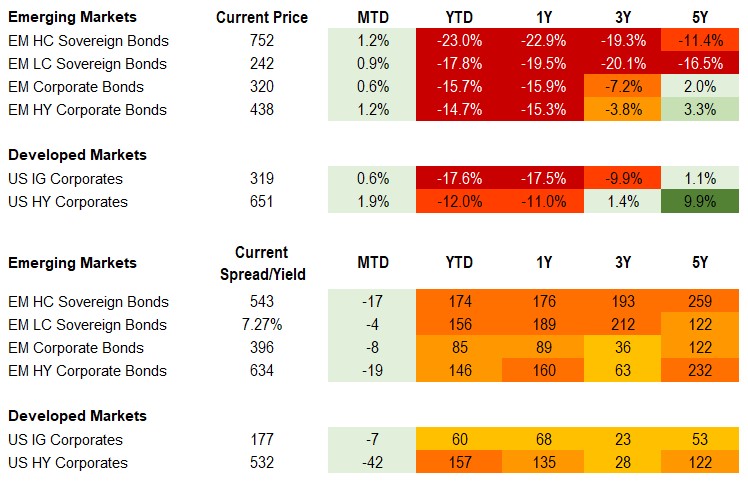
Equities
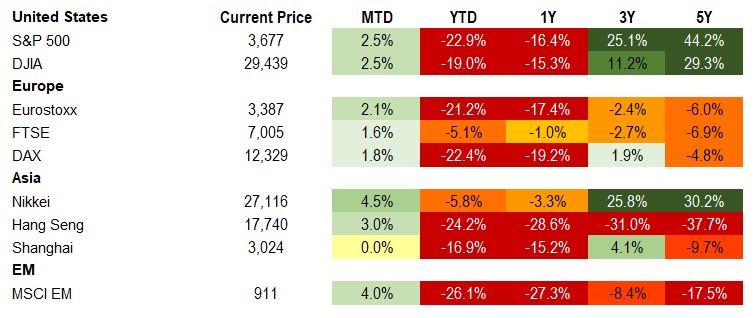
Commodities

Source for data tables: Bloomberg, JPMorgan, Gramercy. EM Fixed Income is represented by the following JPMorgan Indicies: EMBI Global, GBI-EM Global Diversified, CEMBI Broad Diversified and CEMBI Broad High Yield. DM Fixed Income is represented by the JPMorgan JULI Total Return Index and Domestic High Yield Index. Fixed Income, Equity and Commodity data is as of October 7, 2022 (mid-afternoon).
Emerging Markets Weekly Highlights
Lula favorite to win Brazil’s Presidency in run-off against Bolsonaro, but centrist parties dominate Congress
Event: The first round of Presidential Elections in Brazil were more competitive than most polls predicted. Incumbent President Bolsonaro (43.2%, 51.1 million votes) meaningfully outperformed pre-election expectations securing more than two million additional votes compared to his 2018 first round tally and forcing a run-off on October 30th against former President Lula (48.4%, 57.3 million votes). Left-wing icon Lula remains the favorite to win the Presidency, but his Workers’ Party (PT) did not do well in the Congressional elections to the benefit of centrist and center-right parties.
Gramercy commentary: Lula’s five percentage point first round margin of victory over Bolsonaro was smaller than most polls projected. However, Lula remains the favorite to win the Presidency; he has already received the endorsements of 3rd and 4th placed candidates Simone Tebet (4.2%, 4.9 million votes) and Ciro Gomes (3%, 3.6 million votes) who represent around 8.5 million (mostly centrist) voters. Both Lula and Bolsonaro will try to attract those votes in the four weeks prior to the second round, but the votes will likely favor Lula. In this context, we expect that both candidates will be shifting their policy positions toward the political center over the coming weeks, which would be a market-positive development. Moreover, if elected President on October 30th as we expect, we think that Lula will likely appoint a decent number of centrist ministers to his cabinet, which will also be welcomed by markets. While Lula’s personal appeal with Brazilian voters against the highly divisive figure of Bolsonaro anchors his frontrunner status, his left-wing PT party underperformed in the Congressional elections. In fact, centrist and center-right parties were the big winners in both chambers, producing what most investors would perceive as a market-friendly outcome. While Lula’s ability to implement policy would most likely be diminished by a center/right-leaning Congress, we expect markets to look at this through a “glass half full” lens as it means that Brazil’s economic/fiscal policy is unlikely to steer radically to the left under Lula, though he is expected to have a decent degree of governability on a transactional/case-by-case basis. This is a balance of outcomes that we think markets will interpret as the “best of both worlds”, thereby supporting risk appetite.
Poland pauses rate hikes noting this is not yet a formal end to the hiking cycle
Event: The National Bank of Poland (NBP) held its benchmark rate at 6.75% this week in contrast to market expectations for a 25bps hike. While there has been a recent dovish shift from the NBP, Governor Glapinski indicated an open-ended ‘wait and see’ approach, stating that this is not yet a formal end to the hiking cycle. This follows continued broad-based acceleration in September inflation to 17.2% (core 9.9%) vs 16.1% (core 9.3%) in August and some stronger than expected, albeit slowing, economic activity indicators.
Gramercy commentary: We see the statement that the hiking cycle is not yet over as crucial for credibility given deeply negative real interest rates amid still accelerating inflation and the widening of fiscal and current account deficits. While a sharper slowdown in growth in the coming quarters could more swiftly ease inflation pressures, real rates are likely to remain negative absent further hikes, leaving the PLN vulnerable to depreciation pressure and risk of further fueling inflation.
Emerging Markets Technicals
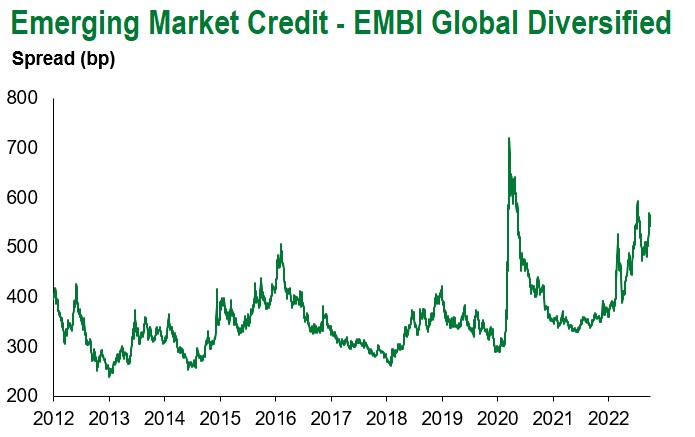
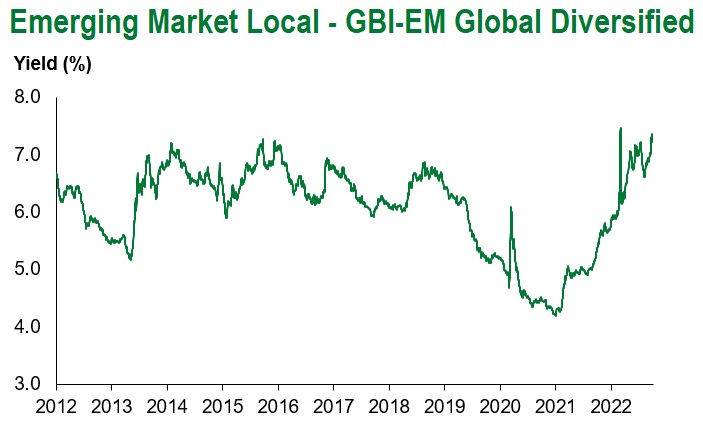
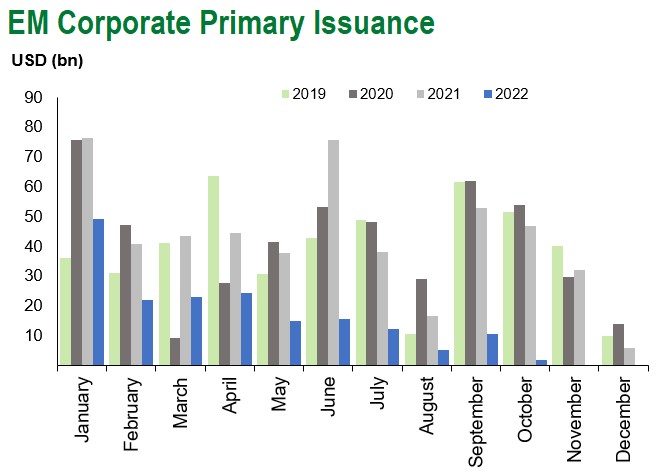
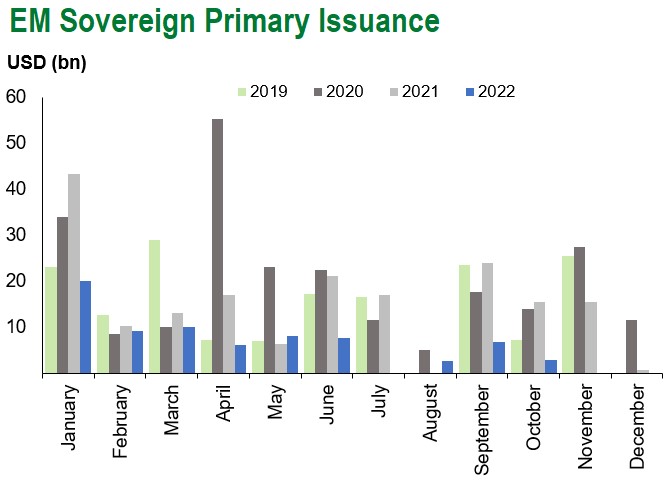
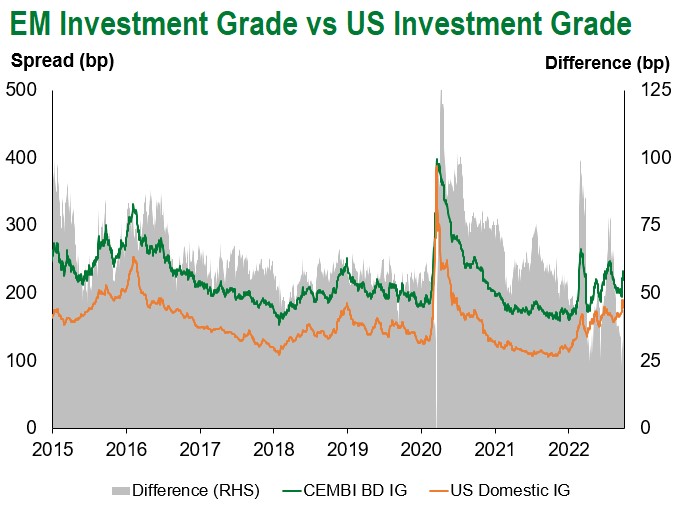
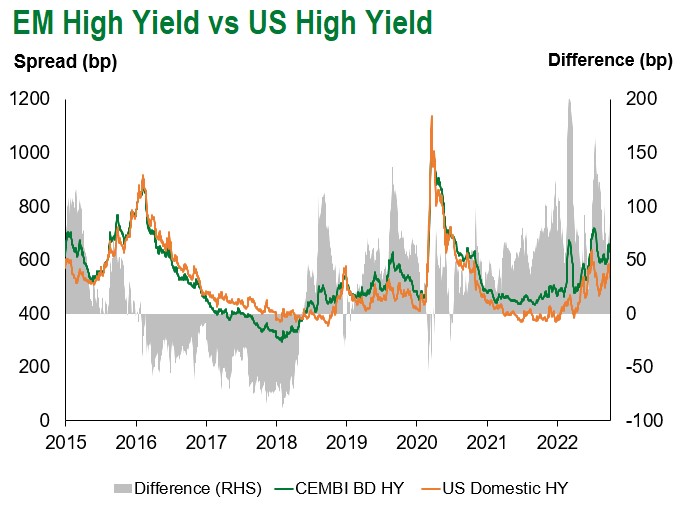
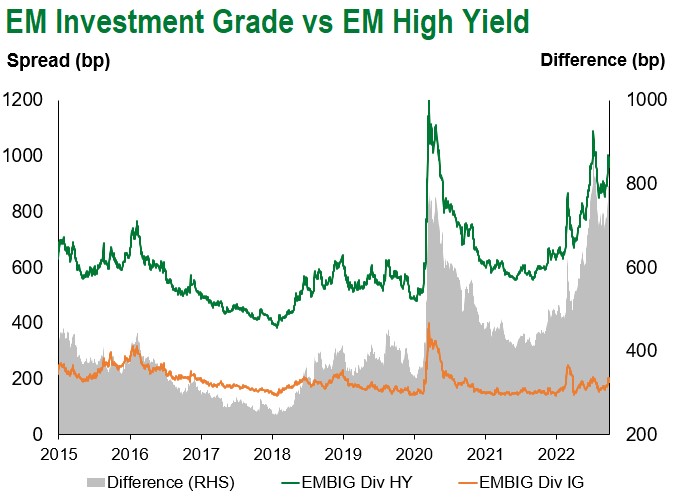
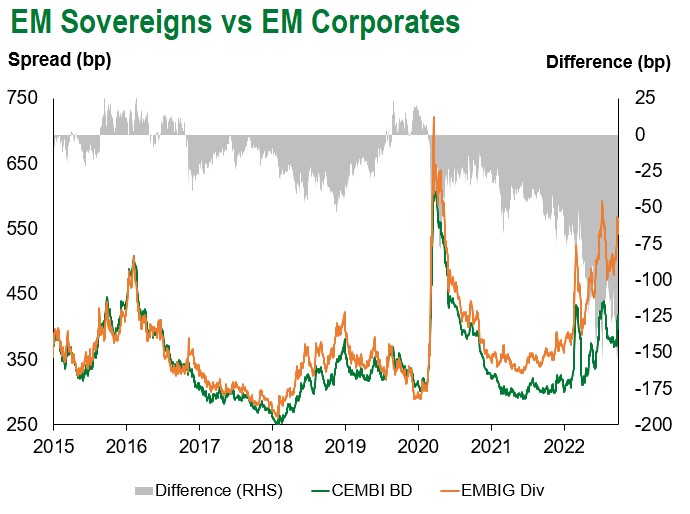
Emerging Markets Flows
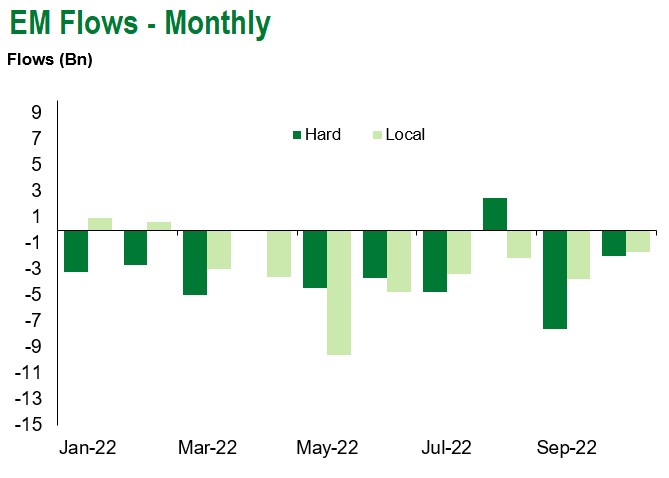
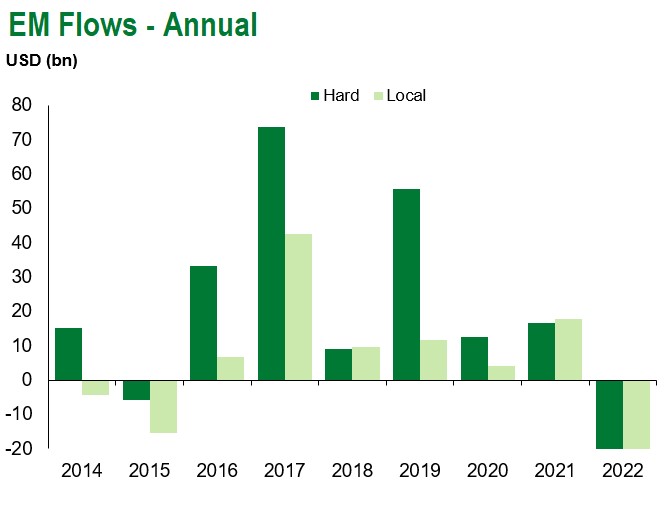
Source for graphs: Bloomberg, JPMorgan, Gramercy. As of October 7, 2022.
COVID Resources:
Johns Hopkins COVID-19 Case Tracker
For questions, please contact:
Kathryn Exum, CFA ESG, Director, Co-Head of Sovereign Research, [email protected]
Petar Atanasov, Director, Co-Head of Sovereign Research, [email protected]
James Barry, Director, Deputy Portfolio Manager, [email protected]
This document is for informational purposes only. The information presented is not intended to be relied upon as a forecast, research or investment advice, and is not a recommendation, offer or solicitation to buy or sell any securities or to adopt any investment strategy. Gramercy may have current investment positions in the securities or sovereigns mentioned above. The information and opinions contained in this paper are as of the date of initial publication, derived from proprietary and nonproprietary sources deemed by Gramercy to be reliable, are not necessarily all-inclusive and are not guaranteed as to accuracy. This paper may contain “forward-looking” information that is not purely historical in nature. Such information may include, among other things, projections and forecasts. There is no guarantee that any forecasts made will come to pass. Reliance upon information in this paper is at the sole discretion of the reader. You should not rely on this presentation as the basis upon which to make an investment decision. Investment involves risk. There can be no assurance that investment objectives will be achieved. Investors must be prepared to bear the risk of a total loss of their investment. These risks are often heightened for investments in emerging/developing markets or smaller capital markets. International investing involves risks, including risks related to foreign currency, limited liquidity, less government regulation, and the possibility of substantial volatility due to adverse political, economic or other developments. References to any indices are for informational and general comparative purposes only. The performance data of various indices mentioned in this update are updated and released on a periodic basis before finalization. The performance data of various indices presented herein was current as of the date of the presentation. Please refer to data returns of the separate indices if you desire additional or updated information. Indices are unmanaged, and their performance results do not reflect the impact of fees, expenses, or taxes that may be incurred through an investment with Gramercy. Returns for indices assume dividend reinvestment. An investment cannot be made directly in an index. Accordingly, comparing results shown to those of such indices may be of limited use. The information provided herein is neither tax nor legal advice. Investors should speak to their tax professional for specific information regarding their tax situation.
